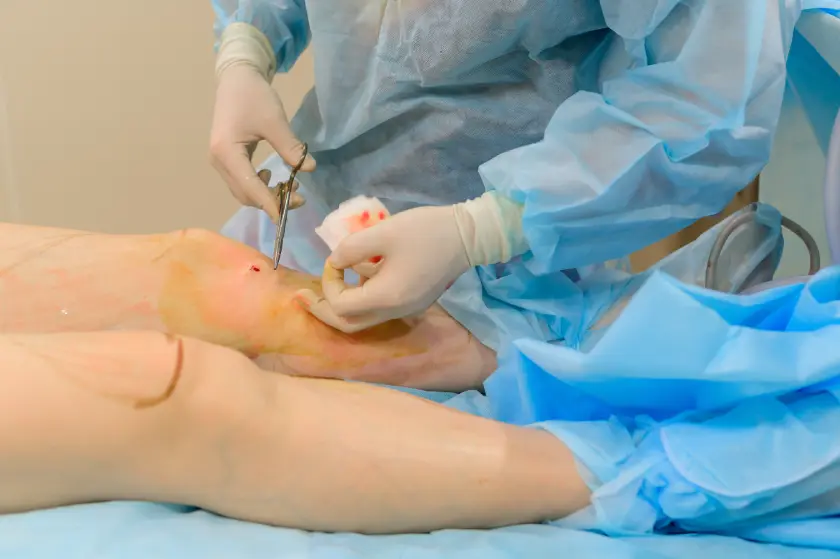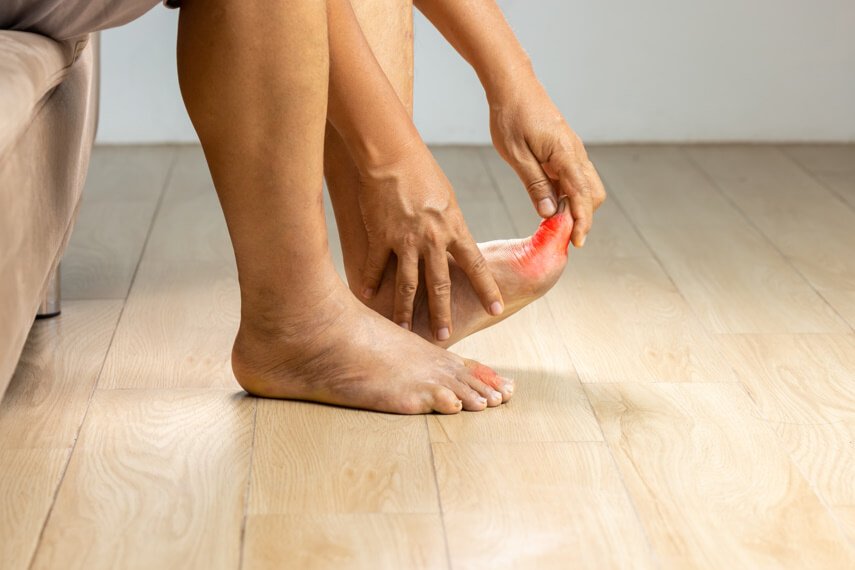Fasciotomy: Overview, Preparation, Technique
In certain severe foot conditions, time is tissue. One such urgent situation is compartment syndrome, where pressure builds up within the muscles to dangerous levels. If untreated, this can cut off the blood supply, damage nerves, and lead to tissue death. For diabetic patients, especially those with foot ulcers or infections, this can pose a significant risk of limb loss. Fasciotomy is a life- and limb-saving surgical procedure designed to relieve that pressure and restore healthy circulation. At Surat Diabetic Foot and Ulcers Clinic, we specialise in timely diagnosis and precision surgical care to protect both mobility and quality of life.
What is a Fasciotomy?
Fasciotomy is a surgical technique in which the fascia, a tough, inelastic layer of connective tissue that encases muscles, blood vessels, and nerves, is carefully cut open to release excessive pressure within a muscle compartment. Under normal circumstances, the fascia acts as a protective sheath, but when swelling or bleeding occurs inside this compartment, it has little capacity to stretch. The resulting rise in pressure can choke off circulation, compress nerves, and rapidly damage tissues.
By opening the fascia, the fasciotomy procedure immediately relieves this pressure, restores blood flow, and halts further tissue damage. When performed for the lower limb, particularly in cases involving severe injury, infection, or diabetic foot complications, it is often referred to as a fasciotomy foot procedure.
This surgery is not simply about making an incision; it is a calculated, limb-saving intervention aimed at preserving the function, mobility, and viability of the affected foot or leg. Because the damage caused by compartment syndrome can progress within hours, fasciotomy is often performed as an emergency operation. In many cases, timely intervention can mean the difference between a complete recovery and permanent disability or amputation.
When is Fasciotomy Recommended?
A fasciotomy procedure is typically advised in:
- Acute compartment syndrome caused by trauma, fractures, crush injuries, or burns.
- Severe infections or rapidly progressing cellulitis in the foot or lower leg.
- Vascular compromise after revascularisation surgery, especially in diabetic or peripheral artery disease patients.
- Post-surgical swelling when other measures fail to relieve pressure.
For diabetic patients with foot ulcers, swelling from infection or poor circulation can increase the risk of compartment syndrome. Early detection and intervention through a fasciotomy can sometimes prevent amputation.
Pre-operative Preparation
Preparation for a fasciotomy foot procedure begins with:
- Clinical assessment: Evaluating symptoms such as severe pain, swelling, numbness, or changes in skin colour.
- Diagnostic tests: May include compartment pressure measurement, Doppler studies, or imaging to assess circulation.
- Stabilisation: Managing the patient’s overall health, controlling infection, stabilising blood sugar levels (especially in diabetics), and ensuring they are fit for surgery.
- Informed consent: Discussing the urgency, expected outcomes, and possible need for additional procedures later.
In emergency cases, preparation is swift, as delays can significantly affect recovery and limb preservation.
Fasciotomy Procedure (Step-by-Step)
The fasciotomy technique generally follows these steps:
- Anaesthesia: Usually regional or general anaesthesia, depending on patient health and urgency.
- Incision: A long incision is made over the affected compartment. In the foot, the location depends on the involved muscles and compartments.
- Opening the fascia: The surgeon carefully cuts through the fascia to relieve pressure.
- Inspection and debridement: Damaged or dead tissue may be removed to prevent infection.
- Leaving the wound open: In many cases, the incision is not closed immediately to allow swelling to reduce. A sterile dressing or negative-pressure wound therapy may be applied.
- Closure or grafting: Once swelling subsides (usually within a few days), the wound is closed surgically or with a skin graft if needed.
This technique prioritises limb salvage, and in cases of fasciotomy foot, it directly prevents tissue death that could otherwise lead to amputation.
Postoperative Care and Recovery
Recovery after a fasciotomy involves:
- Pain management to ensure comfort during healing.
- Infection prevention through antibiotics and wound care.
- Wound monitoring and dressing changes, often under medical supervision.
- Physiotherapy to restore mobility and strength once healing progresses.
- Blood sugar control in diabetic patients aids wound healing.
Full recovery depends on the extent of tissue damage before surgery and the patient’s overall health. Early intervention usually results in better outcomes.
Risks and Complications
Like any surgical procedure, a fasciotomy has potential risks:
- Infection at the wound site.
- Prolonged healing time, especially in diabetic patients.
- Scarring or skin graft requirement.
- Nerve injury or chronic pain.
- Rarely, recurrence of compartment syndrome.
These risks are carefully weighed against the life- and limb-saving benefits of the surgery.
Conclusion
A fasciotomy procedure can make the difference between saving and losing a limb. For diabetic patients, particularly those with foot complications, understanding what fasciotomy is, its purpose, and the urgency it demands is crucial. At Surat Diabetic Foot and Ulcers Clinic, our experienced team ensures timely diagnosis, precise execution of the fasciotomy technique, and comprehensive post-surgical care to promote recovery and protect mobility.
FAQs
Is fasciotomy a major surgery?
Yes. While the surgical steps are straightforward, it is performed in urgent, high-risk situations and can be life- or limb-saving.
How long does it take to recover from a fasciotomy?
Recovery can take weeks to months, depending on the severity of the condition, the patient’s health, and whether additional procedures like skin grafting are required.
Will I need more than one surgery?
In some cases, a second surgery may be needed for wound closure, grafting, or further debridement.
Is fasciotomy painful?
Pain is managed with appropriate anaesthesia during surgery and pain control measures afterward.
Can fasciotomy prevent amputation?
Yes. When performed promptly, especially in cases of fasciotomy foot, it can prevent severe tissue damage that would otherwise require amputation.



.jpg)

